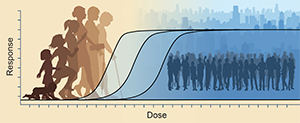Symposium Webinar
Using New Approach Methodologies to Address Variability and Susceptibility Across Populations
Wednesday, October 26 – 9:00 a.m.-12 noon EDT
Thursday, October 27 – 9:00-10:30 a.m. EDT
Slides and video from the presentations are available below.
Different human populations exhibit different levels of susceptibility to toxic effects from chemical exposure, presenting a complex problem for chemical risk assessment. Human cell-based and computational new approach methodologies (NAMs) could potentially be used effectively to characterize susceptibility of different human populations.
NICEATM organized this symposium on using NAMs to address variability and susceptibility across populations. The virtual event attracted over 250 attendees representing government, academia, and a diversity of industrial and nongovernmental sectors. An interdisciplinary group of over 50 members was invited to participate in a discussion session following the symposium. The symposium identified:
- Opportunities for NAMs to provide relevant information on population variability and susceptibility to environmental chemicals.
- Information needs for population variability and susceptibility where NAMs could be designed or improved to fill those needs.
Speakers at the symposium highlighted information needs for population variability and susceptibility and considered where NAMs could be designed or improved to fill those needs. Case studies highlighted how NAMs (in vitro tests, in silico predictions, and tests using non-mammalian organisms) could be applied to address population variability and susceptibility factors such as life stage, genetics, comorbidities, lifestyle, and mixed exposures.
An important goal of the event was to initiate conversations among representatives of government, industry, academia, and the environmental justice community, so that collectively they might listen, learn, and build trust. Discussion participants stressed the importance of risk assessment activities being designed to protect all populations, especially the most vulnerable. In particular risk assessments should address cumulative exposure from both chemical and non-chemical stressors. The discussions identified barriers and opportunities for follow-up workshops that will address scientific, regulatory, and community perspectives and foster interdisciplinary collaborations to develop and implement the best, most responsive science in this area.
Journal Collection Includes Articles on NAMs to Address Population Variability and Susceptibility
In November 2024 the journal Human Genomics published a collection of articles on "New Approach Methodologies to Address Population Variability and Susceptibility in Human Risk Assessment." This collection focuses on the development and use of NAMs such as in vitro, in silico, and small organism models that address variability or factors associated with susceptibility to adverse effects of chemical exposure. Population-level variability and susceptibility can arise from numerous factors such as genetics, life stage, concurrent stressors, and co-morbidities. Papers deal with human health risk assessment and feature research developing, refining, or implementing NAMs with consideration of population variability or susceptibility. NICEATM scientists Helena Hogberg-Durdock (National Institute of Environmental Health Sciences) and Kim To (Inotiv, contractor supporting NICEATM) and NICEATM Director Nicole Kleinstreuer were guest editors for the collection.
In advance of the symposium, a webinar series highlighted NAMs that incorporate variability and susceptibility into the evaluation of chemical safety. The webinar series, which concluded in early October, was co-organized by NICEATM and PCRM. Information about the webinar series, including recordings of past webinars, is available on the PCRM website.
Presentation Slides
Overcoming Challenges in Use of NAMs to Inform Population Variability and Susceptibility in Regulatory Decision-making: Maureen Gwinn, U.S. Environmental Protection Agency
Chemical Exposures and Impacts at the Local Public Health Level: Shirlee Tan, Public Health – Seattle & King County
Determining the Role of Environmental Exposures on Kidney Health Outcomes in Tropical Farming Communities: Nishad Jayasundara, Duke University
Investigating GxE Neurotoxicant Vulnerabilities Across Life Stage and Populations Using iPSCs: Aaron Bowman, Purdue University
Integrating Bayesian Approaches with PBPK Modeling in a Human Health Risk Assessment: Wei-Chun Chou, University of Florida
Comparative Genomics for Precision Toxicology: Brian Oliver, National Institutes of Health


